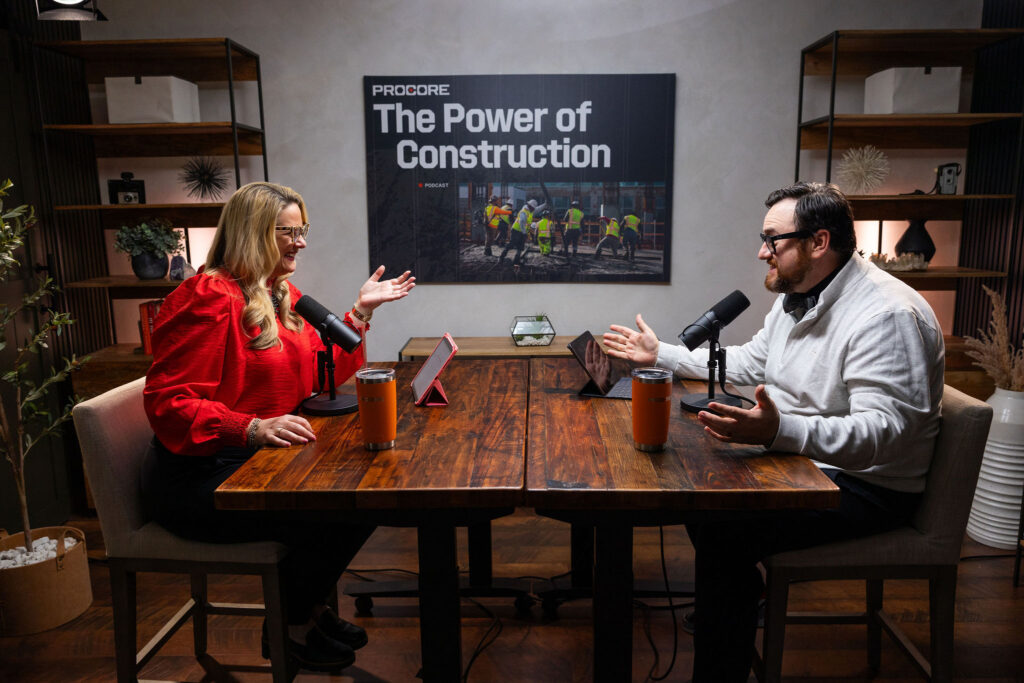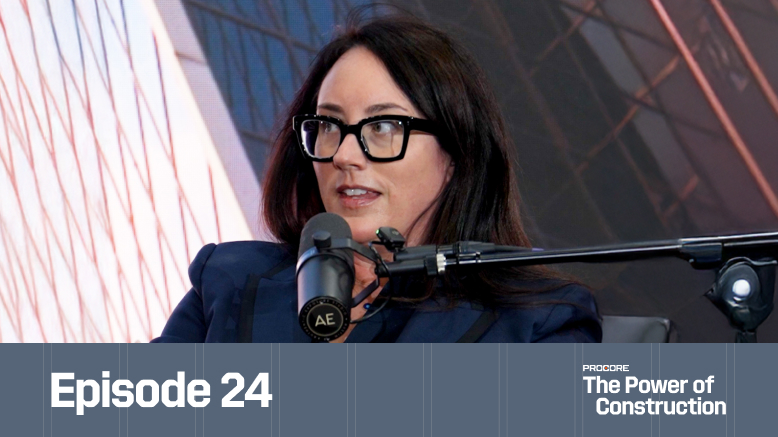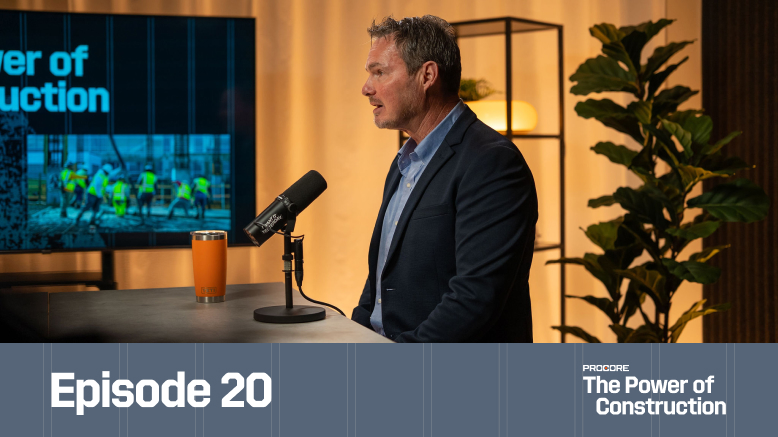Welcome to The Power of Construction
Sasha Reed and Kris Lengieza introduce The Power of Construction podcast, highlighting industry leaders who are evolving their business today to forge a better future tomorrow.
Together representing over 40 years of experience in construction and technology, they aim to sit down with the best and brightest minds in construction to explore how leaders overcome their greatest challenges while achieving operational effectiveness and becoming better stewards of their people and resources.
Why Productivity Matters: The $2.8 Trillion Problem
Construction contributes about 13% of global GDP, yet while other industries have made leaps in productivity, construction continues to lag behind. In the U.S. alone, this productivity gap costs the economy about $2.8 trillion each year.
Despite projected global construction spending increases from $13 trillion in 2013 to $22 trillion in 2040, the industry's productivity has stagnated and even declined in recent years. The challenge isn't that construction is incapable of building faster and better—it's that we haven't yet achieved this potential.
Introducing Today's Guests: Peter Tateishi & Josh Bone
Peter Tateishi serves as CEO of AGC of California, the Associated General Contractors' largest chapter representing 900 member firms. A third-generation construction professional who started as a laborer, Tateishi brings personal experience to understanding workforce challenges and contractor perspectives.
Josh Bone is Executive Director of ELECTRI International, the research and innovation arm of NECA (National Electrical Contractors Association). Leading a team of 25, he oversees workforce development, health and safety research, and strategic innovation in the electrical contracting sector.
The Real Workforce Crisis: A Skills Shortage, Not Just Numbers
The construction workforce challenge isn't simply about needing more workers—it's about losing skilled, knowledgeable workers without adequate replacements. The industry has about 400,000 open positions at any given time, but the deeper issue is the gap between retiring experienced workers and incoming workers with equivalent expertise.
A significant 41% of construction workers will retire by 2031, taking decades of tacit knowledge with them. This creates what AGC calls a "skills shortage" rather than just a labor shortage, as new workers need 3-5 years (approximately 10,000 hours) to develop journeyman-level capabilities.
The Training Paradox: No Time to Develop the Next Generation
Contractors face a catch-22 situation: they need to train the next generation of workers, but current project schedules and profit margins don't allow time for proper mentorship. The traditional apprenticeship model where experienced workers train newcomers on job sites requires additional time and resources that compressed schedules can't accommodate.
Industry data shows it takes about 10,000 hours to develop a journeyman-level worker—equivalent to five years working 2,000 hours annually. During this time, apprentices work more slowly as they learn, creating short-term productivity impacts that current project economics can't absorb.
Why Owners Need to Reconsider Unrealistic Project Schedules
Unrealistic schedules prevent proper training and mentorship. When owners compress timelines—such as reducing work from 6-10s to 5-10s without changing the end date—contractors can't afford to bring on apprentices who learn on the job and naturally work slower initially.
This creates a vicious cycle where the industry can't develop the next generation of skilled workers because there's no time for training. Owners must understand that supporting workforce development on current projects directly benefits future project success and productivity.
Reimagining the Superintendent Role
The superintendent role is critically important to job success, schedule management, and overall site coordination, yet few people are looking toward this career path. The industry lacks the time and ability to mentor the next generation of superintendents due to schedule pressures.
General contractors struggle to find experienced individuals who want to pursue superintendent roles, creating a significant gap in project leadership capabilities. The industry needs reprieve from owners to allow experience development and proper mentorship programs.
How We're Losing Legacy Knowledge
The aging workforce brings physical and emotional challenges, with many workers being asked to stay longer than originally promised when they started their careers. Traditional construction retirement expectations around age 55-60 have shifted toward working until 67-70, similar to other industries.
This extends beyond the original promise made to workers about career longevity. Some contractors are asking retired workers to return as highly paid consultants because there's no pipeline to promote from within, creating additional cost pressures and margin impacts.
Rethinking Roles and Retraining Older Workers
While some contractors are making efforts to advance and retrain experienced workers, the industry's resistance to change often leads to maintaining status quo approaches rather than leveraging experience for innovation.
Some progressive contractors recognize opportunities to use experienced workers' wisdom to learn and change business practices, but this isn't as widespread as needed. The industry needs to balance maintaining valuable experience while embracing necessary changes and innovations.
The Rise of Prefab and Manufacturing Mindsets
The industry must embrace prefabrication, off-site construction, and manufacturing mentalities to address workforce shortages. This requires strategic thinking about when to buy prefab versus build on-site, joint ventures, and specialization.
Contractors need to be more strategic about breaking down jobs and managing risk, including decisions about temporary power, subcontracting, and prefabrication. The convergence of design and construction thinking about means and methods becomes critical for future success.
How Delivery Methods and Contracts Affect People
Traditional hard-bid dynamics create a race to the bottom that disincentivizes innovation and change. Low-bid-wins approaches mean contractors making investments in improvements may lose projects to those maintaining status quo practices.
This system perpetuates a risk mitigation push-down through the entire supply chain, ultimately asking why workers at the bottom should continue in the industry. The lack of collaborative delivery methods particularly impacts small and underrepresented businesses who can't manage or access high-risk projects, limiting industry diversity and growth.
Commoditization and Root Causes of Poor Workforce Conditions
The commoditization of construction work creates systemic problems affecting worker welfare. Most craft workers operate on a "show up, get paid; don't show up, don't get paid" basis without paid sick leave. When workers suffer minor injuries, they often can't afford medical time off, leading to self-medication.
This contributes to construction having nearly one in four opioid overdose deaths across all industries—23% of all opioid overdose deaths. The inability to bid sick leave and worker benefits into projects because of low-bid competition perpetuates these dangerous cycles.
The Rise and Stall of IPD and the Need for Owner Trust
Integrated Project Delivery (IPD) showed promise, with positive feedback from everyone who worked on IPD projects, but owners didn't feel they had enough control or were getting the best price. This led to reduced IPD adoption, though some progressive owners are returning to Target Value Delivery and collaborative planning methods.
The industry needs better contracts that reflect shared benefits rather than commoditizing the process. Current contract terms like "pay if paid," liquidated damages, and unlimited liability create animosity and protectionist behavior rather than collaboration.
What AGC & ELECTRI Are Doing to Reshape the Future
AGC of California focuses on building stronger relationships with owners, especially public owners, to help educate them about being part of the solution beyond just providing budgets and schedules. They're working to help owners recognize construction as a people business rather than a commodity, supporting workers who want growth, challenge, and the ability to provide for their families.
ELECTRI International conducts best practice research and education, converting research beyond white papers into actionable curriculum and tools contractors can operationalize. They're researching productivity, claims management, lean delivery methods, and working with the Project Production Institute on operations science applications.
What Construction Looks Like If We Get It Right
The future could go two directions: either the industry works together with transparency, better contracts, and proper job delivery, or it moves toward manufacturing consolidation with modular delivery and owner-furnished, contractor-installed systems.
The preferred future involves seeing construction professionals as consultants rather than commodities, bringing knowledge and value to projects. This requires thinking more like businesses, embracing technology, and making data-driven decisions that increase profitability while reducing risk exposure.
Rapid Fire Questions
Book Recommendations:
- Josh: The Hard Hat and Breath (audiobook)
- Peter: Outward Mindset series for challenging assumptions
Information Sources:
- Josh: Personal blog and Google Alerts for "artificial intelligence in construction"
- Peter: National peer groups and executive leadership team information sharing
Advice to Younger Self:
- Peter: "Know your worth"
- Josh: "Believe in yourself" and understand that impostor syndrome is real and natural
Future-Shaping Trends:
- Josh: The three -ations: digitalization, industrialization, electrification
- Peter: Data and AI feeding into efficiency improvements
Industry Taglines:
- Peter: "Industry One" - construction as the foundation of all other economies
- Josh: "The American Dream is still alive and well in the construction industry"
Final Thoughts & Call to Action
The conversation concludes with recognition that the industry must capture knowledge before massive retirements, rethink the value of construction workers, and leverage technology to meet next-generation expectations.
Gen Z workers expect employers who provide necessary technology to do jobs better—70% would leave for employers offering better technological resources. The industry has an opportunity to be seen as helping workers make greater impact rather than resisting change.
Success requires intentional productivity management, daily work planning, and measuring what needs to be managed. The industry's future depends on recognizing construction as Industry One—the foundation upon which every other economy is built.




